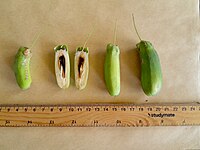Description
Barringtonia neocaledonica is a small tree growing up to 15 m (49 ft) tall. The leaves are arranged in whorls and clustered towards the end of the branches. [3] They are glossy dark green, glabrous (i.e. without hairs), wider at the distal end (obovate) and gradually tapering at the base. [2] [3] The leaf blade extends all the way down to the end of the petiole (leaf stalk), so that the petiole is "winged" (attenuate). [2] [3] The leaves measure up to 30 cm (12 in) long by 12 cm (4.7 in) wide. [2] [3]
The inflorescences are terminal or ramiflorous, pendulous spikes, reaching 50 cm (20 in) or more in length. [2] [3] They carry about 50 white or pale pink sessile flowers. [2] [3]
The fleshy fruit contains a single seed and measures about 6 cm (2.4 in) long and 2 cm (0.79 in) wide. [3]
This page is based on this
Wikipedia article Text is available under the
CC BY-SA 4.0 license; additional terms may apply.
Images, videos and audio are available under their respective licenses.




